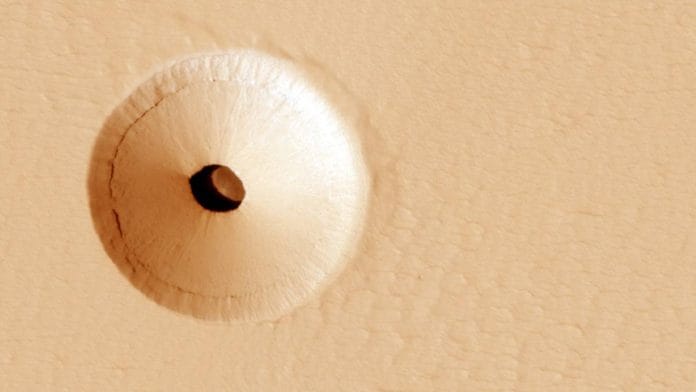New Delhi: A group of researchers from Australia studied crystal formation on the surface of Mars to determine how the Martian environment evolved. What they found is multiple layers of these crystal structures on the red planet, indicating that there were multiple periods in the past when the planet was watery and therefore could have been habitable.
Their research was published in the peer-reviewed journal Sciences Advances this week.
The crystal structures have been studied earlier too—they are large deposits of calcium sulphate minerals found at different locations on Mars. Scientists have theorised that at one point, large craters on Mars used to be lakes of water that contained dissolved minerals, which then crystallised as the water evaporated when conditions changed.
The Australian researchers explain in their paper how they found layers of crystals at the same locations on Mars, buried deep underground. This means there were multiple such periods when the planet was watery, possibly habitable, until conditions changed. While this does not indicate that it could be habitable again, it does suggest that researchers are one step closer to finding out if it could. Read More
Do monkeys grieve like humans?
It has been said that animals have feelings, but they express them differently than humans. In an interesting study conducted by University College London (UCL), anthropologists studied the grieving process of primates and other mammals.
It’s known that when female monkeys lose their infants to death, some carry their bodies around for months. While this could be a display of grief, it was not yet known exactly how monkeys express their grief, and whether they wail, lose their appetite, or show other signs of bereavement the way humans commonly do.
By observing groups of monkeys who had lost their infants versus those who hadn’t, the scientists were able to determine that monkeys indeed do not express grief like humans.
Yes, bereaved mothers did rest less than normal, but otherwise their grief upon losing their infants is categorised more as a “protest” stage of grief. When one is separated from their child or parents, one goes through an initial level of agitation and sadness out of protest. In humans, when the separation continues, this agitation turns to despair. But in monkeys, grief often does not go beyond the one-two month stage of “protest”.
It is the first ever observational study to understand grief processes in primates and was published in the peer-reviewed scientific journal Biology Letters Wednesday. Read More
‘Sunscreen’ & sewing helped homo sapiens 40,000 years ago
A study by University of Michigan scientists explores a period in time 40,000 years ago, when the Earth’s magnetic field changed. This is called a geomagnetic excursion, when the internal rotation of the Earth’s core changes, and it has happened around 180 times in the Earth’s history. The last time it happened was 40,000 years ago and the North Pole moved from its position and shifted to Europe, which was then inhabited by Neanderthals and the first homo sapiens.
When the Earth’s magnetic poles change, one of the biggest impacts is that there is increased solar radiation at the poles, in this case over Europe.
The scientists from University of Michigan postulate there were two things that could have helped homo sapiens survive this phenomenon—sunscreen and tailored clothing.
Archaeologists have found evidence of needles and sewing in caves near Europe from 40,000 years ago, not to mention an increased use of ochre, which is a natural dye that has iron oxide and silica and has sun protection properties.
Now, if someone refuses to wear sunscreen, you can remind them that it is a practice dating back 40,000 years in our species. The research was published in the peer-reviewed journal Sciences Advances Wednesday. Read More
Electrifying railways can dramatically boost air quality
A new study published Tuesday in the peer-reviewed journal Environmental Science and Technology Letters has found that transitioning from diesel to electric trains in San Francisco reduced train commuters’ exposure to black carbon by 89 percent.
This is a huge achievement in terms of the reduction in black carbon concentrations. The study said that by replacing diesel trains with electric ones, the black carbon emission reduction was equivalent to that in other Californian cities that have had years of air pollution regulations. In contrast, changing trains took a few weeks.
The researchers from University of California, Berkeley, measured black carbon pollution in railway stations in San Francisco before and after the electric trains were adopted, and found reasonable declines. While this was a US-specific study, the improvement in air quality led the authors to propose electric trains as a global solution, given that they are faster, more reliable, and less polluting than older diesel-powered locomotives. Read More
(Edited by Nida Fatima Siddiqui)
Also Read: Why do bats not collide while emerging from caves? German, Israeli researchers have an answer






